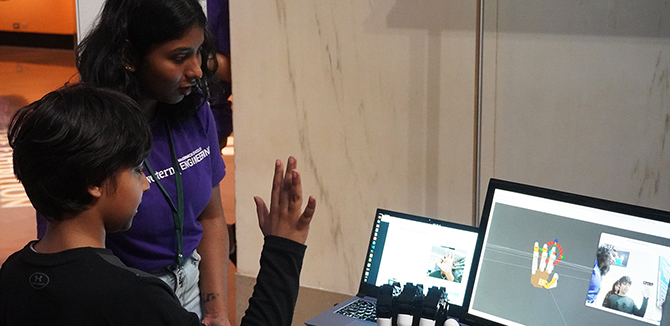Robot Block Party at MSI
MSR students participated in the annual robotics celebration at Chicago's Museum of Science and Industry to present their projects and introduce a new generation to robotics.

How do you explain machine learning to a child?
That was the question Nick Morales (MSR '23) asked himself in April when he and his classmates from Northwestern Engineering's Master of Science in Robotics (MSR) program presented their robotics projects to guests at Chicago’s Museum of Science and Industry (MSI).
"It was hard to find a way to explain the concept that was both simple enough that he could understand it but also connected with him in a way that he could really understand," Morales said. "Getting practice presenting your project to both technical and non-technical audiences is invaluable."
Morales and his classmates were at MSI for the museum's Robot Block Party, an annual celebration that coincides with National Robotics Week.
Morales presented two projects from his MSR classes: a quadruped Unitree Go1 legged robot that could perform autonomous inspections, and a lightsaber-wielding Franka Emika Panda robotic arm that knocked over blocks on command.
"I generally assumed a complete lack of knowledge on the part of the audience, since many had no technical background," he said. "Often visitors would demonstrate some technical knowledge, which I used as a cue to delve deeper into some of the technical details of the topic."
Having interactive elements was key to engage kids, Morales said. He made signs for the robot inspection dog that kids could hold up and use to make the dog perform different actions, such as jumping, dancing, or begging.
Focusing on the interactivity was a key lesson for Marthinus Nel (MSR '23) as well. Nel also presented a robotic dog, although his could be used as a guide dog to help visually impaired individuals navigate their surroundings and avoid obstacles.
Nel created an activity for the children to help them understand how his robot used feet sensors to know it was on the ground.
"I had the kids lift one of their feet up and asked if they could feel the floor with that foot," Nel said. "In response I got an echoed no. Then I had them put their foot down and asked them the same question and got back a echoed yes. Then I'd start explaining how the robot dog had a similar way of knowing its feet are on the ground and I'd proceed to lift the dog up. It would start kicking to try and find the ground until I put it back down."
Presenting their projects to a public audience was a memorable experience for the students. It also was educational.
"Presenting my projects to a wide-ranging audience helped me realize how hard it is to make robots work in the real-world," said Hang Yin (MSR '23), who showcased a ChatGPT-powered robot chef and a robot Jenga assistant. "Since we have always been the developers of these projects, it was hard for us to think about how most people would use these robots on a day-to-day basis. Making a robotics project work once is also far from making it work consistently with very different users."
Dilan Wijesinghe (MSI '23) agreed.
"I thoroughly enjoyed my time," said Wijesinghe, who created a modular robot that can transform into different robots. "It was wonderful to see the next generation engage with robotics and to hear a lot of them wanted to study robotics. It was a great experience also to explain my project to people, something that I believe will prove invaluable for interviews later on in my career."
MSR codirector Matthew Elwin said that confidence is something he always looks for during the annual event.
"Watching the student’s confidence level grow as they interact with people of all ages and experience-levels and communicate about their project is an extremely satisfying experience," he said. "The best part of the trip was when a group of children got so excited about a robot dog that they all sat in a semi-circle in the middle of the museum floor to watch it for several minutes."

